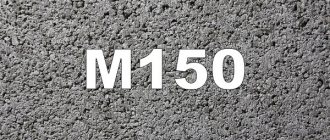One of the features of building materials is related to the presence of porous areas. They complicate the measurement of specific gravity because it is necessary to weigh an element of ideal density to obtain accurate information. This means that the concrete sample would have to be crushed. It is technically difficult to perform this, and it is necessary during serious examinations. And yet, what is the specific gravity of concrete m200?
Classification of concrete by weight
It is the main component in many construction works and has a high strength index. First of all, it is determined how much 1 m3 of m200 concrete weighs, because based on this characteristic the application features are determined.
Concrete mass is used for almost any work. For this reason, composition characteristics include its distribution by class and brand. This allows you to accurately select concrete for a particular purpose.
Based on weight categories, concrete is divided into the following groups:
- Thermal insulation - concrete is made of cement material and filler. After kneading, a structure is formed that has up to eighty-five percent voids. It is used in the manufacture of structures that have increased requirements for heat conductivity. This category includes mixtures weighing up to five hundred kilograms per cubic meter. Sometimes, to increase the level of strength, plasticizer additives are used.
- Light - the mass of this solution is 500 - 1,800 kg. Special blocks are made from it, having pores in their structure, formed by adding foaming agents or fillers with a cellular structure.
- Heavy is the most common group in the construction industry. This concrete is considered an ideal option for the construction of structures that have load-bearing functions. A cubic meter of mass weighs from 1,800 to 2,500 kg, and this figure fully depends on the proportions of sand and filler.
- Super heavy - metal fillers are used in manufacturing, increasing the weight to the maximum level - more than 3,000 kg per cubic meter.
It should be remembered that porous structures do not withstand frost well. During installation, you will have to take care of waterproofing protection.
Is it necessary to buy cement for future use?
Concrete is a quickly hardening mortar; of course, you can’t prepare it for future use, but you shouldn’t buy cement in large quantities in advance. Fresh cement mixture clumps quite quickly, thereby significantly losing its properties. To check the freshness of the cement, just squeeze a handful of the mixture in your palm. Fresh material behaves like dry sand and falls out through your fingers. If lumps form after compression, it means that the cement has already lost some of its qualities and needs to be used as quickly as possible.
A properly selected concrete mixture will not only make the work easier, but will also save time and construction costs.
Specific and volumetric weight of concrete
The most commonly used characteristic is the volumetric weight of concrete grade M200. This indicator is determined by measuring the mass of the finished concrete composition in a specific volume. The value may vary and depends on the fillers used, the presence of pores, air or gas bubbles.
The weight of concrete m200 in 1 m3 ranges from 2,300 to 2,500 and above. This group includes mixtures in which crushed stone is used as a filler. For medium-sized concrete, perlite, expanded clay or aramzit are used, which lightens the weight to 1,200 - 1,800 kg.
You need to know that pores appear in every type of concrete due to evaporating water included in the composition. And to clarify the weight of 1 m3 of M200 concrete, there is no need to contact search engines by entering the appropriate queries. It is enough to use volumetric weight indicators, as in the case of sand, crushed stone, brick and other materials.
Some people make the mistake of believing that its weight depends on the strength of concrete. The strength of the mixture is influenced by the brand of cement composition, and the mass depends on the type of filling component, its quantity and fractions.
If it is necessary to clarify the specific gravity of concrete m200 in 1 m3, then this can be done approximately by adding up the mass of sand, cement composition, fillers and water.
Cement is the basis of concrete
The main component of concrete mixtures is cement. The density of fresh cement fluctuates around 1100-1200 kg/m3, compacted cement mixture has a density of about 1500 kg/m3. In the production of reinforced concrete products, the average cement density of 1300 kg/m3 is used in calculations. The reasons for this discrepancy are explained by the presence of free space between the particles of matter. The larger they are, the more air voids the cement contains and the lower its specific gravity.
The filler that is added to the concrete mixture also matters. It can be light tuff or expanded clay with voids inside, which significantly support the weight of the finished solution. Large amounts of sand and crushed stone make concrete denser and heavier.
Concrete grade m200
This type is considered more common. Such concrete is used for pouring stairs and foundations, when constructing paths and floors. The number “200” means that this concrete grade can withstand loads of up to two hundred kilograms of force per square centimeter.
M200 – category of lightweight concrete. The density of the material is quite small, and this is explained by hollow additives. The specific gravity depends on the volume of water in the solution and on the density values of sand and crushed stone. As a rule, this figure is within 1,500 kg per cubic meter.
To prepare M200 concrete use:
- cement M400 – M500 (one part);
- water at the rate of 42 liters per 10 liters of cement;
- sand (2.8 shares);
- crushed stone granite or lime (up to 4.8 parts).
Various additives can be used to improve certain characteristics.
The main performance indicators of M200 concrete are:
- specific gravity 1,500 – 2,500;
- strength index B15. Concrete can withstand loads up to 196 kg;
- frost resistance. If a good filler is used, the concrete will withstand at least one hundred freezing and thawing cycles;
- waterproof grade – W4, maximum pressure that concrete will withstand and not allow moisture to pass through – 4 atm;
- if water and the weight of cement in 1 m3 of m200 concrete are taken in standard quantities, then the cone settlement will be 5 - 20 cm. This parameter may change due to the introduced plasticizers. As the amount of water increases, the strength of the material decreases;
- You can work with such a concrete solution at temperatures ranging from five to thirty degrees Celsius.
How much does a cubic meter of concrete weigh?
The reduced mass of concrete is one of the important indicators used in the design of building products. Taking into account the overall dimensions, the average weight can be calculated. Based on the results obtained, the load on various structural elements is determined.
Types of concrete
Based on volumetric mass, concrete is divided into several groups:
- density below 500 kg/m³ - especially light concrete group;
- 500...1800kg/m³ - lightweight concrete;
- 1800...2200kg/m³ - lightweight group of concretes;
- 2200...2500kg/m³ - heavy class of concrete;
- density indicator above 2500 kg/m³ - especially heavy concrete.
The heavy group of concretes is the most common in construction.
Components and internal structure of concrete that determine its weight
- lightweight concrete includes gas and foam concrete, mixtures based on expanded clay, tuff, and pumice;
- lightweight concrete, for example, slag concrete;
- heavy concrete - mineral fillers are used, for example, quartz sand, gravel, crushed stone;
- a particularly heavy type of concrete - fillers based on groups of minerals are used, for example, barites, magnetites, limonites.
When calculating concrete and reinforced concrete structures, they are guided by SNiP 2.03.01-84 (Sanitary Norms and Rules) and GOST 25192-82, which determine the physical and technical properties of concrete, including density.
Weight of one cubic meter of heavy concrete (generalized data)
| Concrete grade | M100 | M200 | M250 | M300 | M350 | M400 | M500 |
| Weight of 1m³ of concrete, kg | 2495 | 2435 | 2350 | 2390 | 2500 | 2380 | 2300 |
The table shows that 1 m³ weighs 2300...2500 kg. It follows from this that in preliminary calculations we can assume an average concrete density of 2400 kg/m³. Naturally, to obtain more accurate data, it is necessary to take into account the brand of concrete used.
If reinforced concrete structures are used in construction work, the density of concrete must be increased by 2.5...10%. The average data for reinforced products is 2550 kg/m³.
In the case of using concrete of different classes, you can be guided by the following data:
| Type of concrete, filler used | Weight 1m³, kg |
| Reinforced concrete | 2400…2700 |
| Classic heavy concrete | 2300…2500 |
| Tuff-based filler | 1200…1500 |
| Pumice based filler | 800…1500 |
| Concrete based on volcanic slag | 800…1500 |
| Concrete based on blast furnace slag | 1200…1900 |
| Expanded clay concrete with quartz sand | 800…1250 |
| Ash gravel concrete | 900…1400 |
| Foam concrete, aerated concrete | 400…1100 |
| Foam silicate, gas silicate | 300…1100 |
| Concrete with vermiculite additive | 400…800 |
| Concrete based on boiler slag | 1100…1700 |
| Concrete with perlite additive | 600…1650 |
Determination of concrete mass
When determining the mass of concrete in practice, a number of information should be taken into account:
- the masses of the solution and the hardened mixture will be different, since the water included as one of the components will partially evaporate during the drying process of the concrete;
- the density of concrete is largely determined by fillers and its internal structure;
- the final mass of the concrete mixture depends on the method of concrete preparation - as a rule, when manual labor is used, the density differs to a lesser extent than when using a mechanical mixing method;
- The use of a deep method of compacting the mixture allows you to increase the strength of concrete by obtaining a higher density, that is, 1 m³ will weigh more.
Note. Specific gravity and density of a substance are different quantities both in name and in meaning.
The value of the final density is important to know not only when designing a construction project using concrete - this data will be needed for transport companies carrying out, for example, the removal of a dismantled concrete product.
We will advise on the choice of brand and volume of concrete for your construction site. We will make calculations and offer the best commercial offer.
poznaibeton.ru
Application of concrete m200
The material is universal; its main characteristics make it possible to use concrete in the construction of various structures that are planned for operation under standard load conditions. The scope of application of concrete is as follows:
- arrangement of floor screeds, foundations, retaining walls, stairs and other monolithic elements;
- arrangement of light-loaded structures;
- production of curbs, paving slabs, floor slabs, blocks and other reinforced concrete products;
- performance of reinforcement works;
- during road construction it is used for arranging cushions;
- during restoration activities.
M300
This brand is also often found in the construction of various types of structures. For example, it is used in the construction of airfield pavements and road surfaces. The specific m-m of concrete M300 will be 18 t/m3.
The following ingredients are used in the manufacture of the material:
- cement grades 400 or 500;
- fillers;
- sifted sand;
- water.
How much cement is needed per 1 cubic meter of concrete can be found in this article.
How does specific gravity affect the quality of concrete?
This parameter determines the type of solution suitable for a particular job. More dense compositions are used for load-bearing structures; secondary problems are solved with the help of lightweight concrete. The density indicator is influenced by the size of the aggregate grains and a decrease in the amount of water. If it is necessary to increase weight, then plasticizers can be used.
In addition to the strength indicator, water resistance and frost resistance depend on the volumetric weight. Lightweight and porous concrete compositions are distinguished by another important characteristic - sound insulation. In this case, there is a feedback - the denser the concrete, the worse it insulates and protects against noise. In addition, the concrete grade determines the level of porosity - the higher it is, the less air the concrete contains.
The weight of concrete grade 200 1 m3 can be clarified in special tables.
M400
This brand is used for moisture-resistant treatment. M400 concrete is characterized by high strength levels and a very high hardening rate. The following components are used in the manufacture of the material:
- cement;
- sand;
- crushed stone of medium fractions;
- water.
The specific gravity for the M400 will be 2000 kg/m3.











